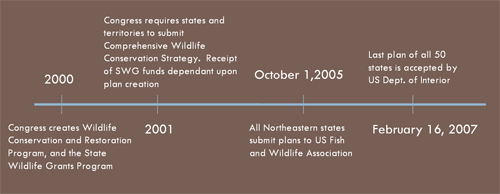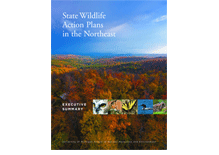Origins of the State Wildlife Action Plans
Wildlife management in the United States originally focused on the protection of food fisheries, agricultural pests and game species. In 1973, Congress passed the Endangered Species Act to protect endangered plants and animals.19 Between 85 and 90 percent of wildlife species, however, remained outside the focus of state fish and wildlife agencies. To meet the management gap, Congress passed the Fish and Wildlife Conservation Act in 1980, helping states, territories, and the District of Columbia protect species that were not hunted, fished, or listed as threatened or endangered. Funding for this program, however, was never sufficient to meet its goals. Instead, states relied on alternative conservation funds, including income tax donations and checkoffs, wildlife license plates, and lotteries to grow “nongame” and “wildlife diversity” programs.
In 2000, Congress created two additional funding mechanisms for wildlife conservation: the Wildlife Conservation and Restoration program and the State and Tribal Wildlife Grants program. By 2002, the two programs had merged into one program, the State Wildlife Grants (SWG) program. Funds allocations are now determined by a formula based 1/3 on land size and 2/3 on population size, with no state receiving more than 5% or less than 1% of available funding. In its first five years, the SWG program appropriated $340 million dollars across all states, or approximately $56 million annually.
In 2001, Congress required states and territories to submit a comprehensive wildlife conservation strategy to a U.S. Fish and Wildlife National Advisory Acceptance Team by October 1, 2005, in order to continue qualifying for SWG funds. Each plan was required to include the following eight common elements, abbreviated here:
- Distribution and abundance of wildlife species,
- Locations and condition of key habitats and community types,
- Wildlife and habitat threats,
- Conservation actions to address these threats,
- Plans for monitoring species, habitats and the effectiveness of conservation actions,
- Plans for review and adaptive management of the strategy,
- Plans to coordinate strategy development, implementation, and review with Federal, state, local agencies and Indian tribes, and
- Opportunities for broad public participation in plan development and implementation.
While all state plans shared a common framework around these required elements, each state varied in its approach and scope. States received guidance about plan development, format, and contents from several sources, including U.S. Fish and Wildlife federal and regional offices, and the Association of Fish and Wildlife Agencies (AFWA), a non-profit organization that represents the state agencies.
All Northeast states submitted their strategies to U.S. Fish and Wildlife Association Northeast Regional National Advisory Acceptance Team (NAAT) by the deadline of October 1, 2005. The NAAT, composed of thirteen wildlife professional representing the USFWS and the regional association of state fish and wildlife agencies, reviewed each strategy's approach to the eight required elements. On February 16, 2007, the final strategy from all fifty states, the District of Columbia, and five U.S. territories was accepted by the Department of Interior.

Plans or Strategies?
Over the course of plan development, states adopted a variety of synonyms to refer to their strategy, depending on which title best resonated with the state approach and public understanding of plan goals. Nationally, the most commonly used plan titles are Comprehensive Wildlife Conservation Strategy and State Wildlife Action Plan. Northeast states remain split in their official reference to the strategy. Six states (Connecticut, Massachusetts, Maine, New York, Pennsylvania, Rhode Island) maintained the Comprehensive Wildlife Conservation Strategy title, while three states (New Hampshire, New Jersey, Vermont) elected to call their strategies Wildlife Action Plans. To maintain clarity, all strategies and plans are referred to by this study as “plans.” Official plan titles will only be used in the context of specific state plans.
The ongoing debate about how best to title the plans reflects the lack of consensus about the role of these documents themselves. Some states approached plan development as an exercise in articulating broad goals and objectives for protecting state species and habitats. Others developed clearer action plans with prioritized short-term and long-term actions.



